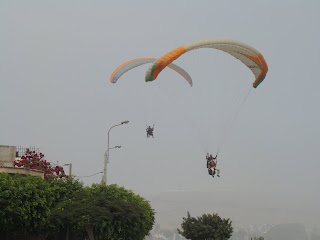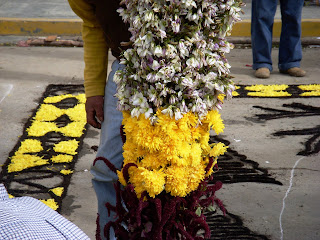
For Easter, both Britt and Addison had a 4-day weekend, so we took off with dog in tow to see part of the central highlands of Peru. Our destination was a town called Jauja, which was briefly the colonial capital of Peru. It's very remote and makes one wonder why the Spaniards ever thought to put a capital city there. The result is that Jauja has some colonial buildings, now pretty shabby. The countryside around Jauja is beautiful. It is in the central Andes, at an altitude of about 3,500 meters (11,500 ft). The hills are covered in patchworks of fields - potatoes, wheat, beans, and other things. There are former Inca terraces all around - including in the most steep, remote, and unlikely places. There are also lots of farm animals, herds of sheep with fuzzy little lambs, furry pigs, cattle, and sorry looking burros.
This is the rainy season in the mountains. The dry and rainy seasons are reversed between Lima (the coast) and the mountains. So it's dry and warm and beautiful here in Lima, but cold and wet in the mountains. In July-Aug it switches and Lima becomes gray, while the mountains become clear and cold.
So, it was very rainy, wet, and dramatic in the mountains at Easter. Because most of the roads are unpaved, and people live for the most part in adobe houses - many with dirt floors, no electricity or running water - there is lots of mud everywhere.
We stayed in a wonderful B&B, called Hostal Manco Capac. It is owned by a French guy, named Bruno, who Valerie met at a meet and greet event for expats in Lima. His wife, Merideth, is a biologist/geneticist who works for the international potato center. They were very interesting, friendly, and generous. They took us on an excursion in their 4-wheel drive pickup truck to visit an Inca ruin. Also along were the other B&B guests, who by coincidence happened to be staff and administrators from Addison's school in Lima, including the principal. It was a jolly group, and we took off with three cars, slogging through thick, slippery mud that felt a lot like driving on snow. Eventually, we had to stop because the road was completely blocked (they were trying to redo it). So we hiked. We never made it to the Inca ruins, because we didn't have enough water and such to sustain the full group that far. But we did admire the gorgeous countryside and crops, cactii, and other interesting things.
We also visited a town called Tarma, which is famous as a big center for flowers. For Easter they line the pavement in the center of town with intricate designs made of flower petals. There are also flower-covered archways. The town of Tarma calls itself the "pearl of Peru". We thought that took some imagination, but enjoyed the flowers and visit nonetheless.
The drive from Lima to Jauja is quite something. There is only one highway. It is paved, though if you go farther north or south, there are parts that aren't paved. The road east from Lima goes from sea level to 5,000 meters (16,500 feet) in about 2.5 hours. Britt was driving. I don't know how he managed. We were pretty groggy, dizzy, and headachey on the way up.
The scenery along the way is quite spectacular - sharp, dramatic mountains on both sides. You also see the "real" Peru. Lots of poverty. And the cars, trucks, and buses that crowd the road tend to be driven by total maniacs, who pass in impossible places (especially blind curves). We saw 5 accidents on the way to Jauja from Lima, including several very nasty-looking ones.
When you reach the highest points (where the raging rivers originate) there are huge mines. Mining is a very important industry in Peru, and one of the biggest sources of its economic growth. They mine things like lead, silver, and other metals/minerals. They have been mining here for hundreds of years or more. In places the mountains are entirely cut away. The lakes and streams are unnatural colors: vivid orange, blue, or green. And the air and soil are very polluted. We drove through the town of Oroyo, which is listed by National Geographic as one of the 10 most polluted places on the planet. There is a big American-owned processing plant or refinery there, called Doe Run. The owner is a bigillionaire, the company is broke, and it was recently bailed out by the Peruvian government, which is trying to preserve jobs and force the company to pay for cleaning up its act. Going through there felt very much like a JRR Tolkein experience - traveling from Hobbit-land to Morder and back again.
I'll let the photos tell the rest of the story:

Wrecked car in front of a scrap metal place on the way out of Lima. No surprise here. People drive like maniacs.

Driving

through the mountain pass at 5,000 meters. It was snowing..

Addison and Bacchus napping in the back seat of our rental car, a Fiat Uno.

Addison and Bacchus in Jauja

Hiking in the hills with our B&B hosts and other guests. Bacchus got to ride in the back of our hosts' pickup truck. He thought that was a-okay.


The countryside is a real patchwork quilt of varing crops. It was rainy and muddy, but also very pretty.

I don't know why this photo is the wrong way, but it shows the state of mudiness of the roads.

Jauja
Setting up the flower designs and archways in Tarma for the Easter procession.



Countryside around Jauja. The scenery is lovely, but the people are very poor.
On the way back to Lima from Jauja we took a short hike in the mountains. We were at about 4,000 meters or more. The mountain behind Britt and Addison is capped with snow, even though it's early fall here.

This sign marks the site of a huge silver mining operation. The mountains are no longer lush, but rather are cut away and dark. It is fairly eerie.





























